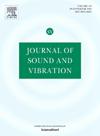Compound nonlinear energy sink with multiple motion types for absorbing energy from wide excitation ranges
IF 4.9
2区 工程技术
Q1 ACOUSTICS
引用次数: 0
Abstract
Nonlinear energy sink (NES) has garnered significant attention since its inception due to its notable broadband vibration reduction capability. However, the introduction of strong nonlinear characteristics by NESs complicates system responses, leading to a loss of effectiveness when the excitation force exceeds a specific threshold. Consequently, NESs have limited applicability in engineering because they are effective only within a constrained range of excitation amplitude. In this study, a compound NES (CNES) with multiple motion types is designed to extend the effective force range while maintaining broadband vibration reduction capability. The CNES is distinguished by its piecewise stiffness, collision mechanisms, and unique design of two-degree-of-freedom oscillators. The wide effective range of the CNES is demonstrated through slow linear sweep and fixed-frequency tests. The results indicate that the CNES effectively reduces vibrations in the primary oscillator (PO) with various resonant frequencies. Notably, the CNES achieves significant vibration reduction over a particularly wide range of excitation amplitude when controlling the PO with relatively high resonance frequencies (approximately 10.5 Hz and 19 Hz). However, a nonnegligible limitation of the CNES is its restricted effective range of excitation amplitude when the PO resonates at lower frequency (approximately 7 Hz). Moreover, five motion types of the CNES are identified and analyzed, with one motion type autonomously emerging in response to changes in excitation parameters, ensuring excellent vibration reduction performance across a wide excitation range. Finally, the performance of the CNES and a degraded single-degree-of-freedom CNES are compared to further demonstrate the extension effect of the multiple motion types on the effective range. The CNES can be used in scenarios where the parameters of protected systems and excitations vary widely, providing a thought to improve the NESs.
具有多种运动类型的复合非线性能量汇,可吸收宽激励范围的能量
非线性能量汇(NES)由于其显著的宽频带减振能力而备受关注。然而,NESs引入的强非线性特性使系统响应复杂化,当激励力超过特定阈值时导致有效性损失。因此,内力在工程上的适用性有限,因为它们仅在有限的激励幅度范围内有效。在本研究中,设计了一种具有多种运动类型的复合NES (CNES),以扩大有效受力范围,同时保持宽带减振能力。CNES以其分段刚度、碰撞机构和独特的二自由度振子设计而著称。通过慢线性扫描和固定频率测试,证明了CNES的宽有效范围。结果表明,CNES能有效地抑制不同频率主振的振动。值得注意的是,当用相对较高的谐振频率(约10.5 Hz和19 Hz)控制PO时,CNES在特别宽的激励幅度范围内实现了显著的减振。然而,CNES的一个不可忽视的局限性是,当PO在较低频率(约7 Hz)谐振时,它的有效激励幅度范围有限。此外,对CNES的五种运动类型进行了识别和分析,其中一种运动类型会随着激励参数的变化而自主出现,从而确保了在广泛的激励范围内具有优异的减振性能。最后,比较了CNES和退化的单自由度CNES的性能,进一步证明了多种运动类型对有效范围的扩展效应。CNES可用于受保护系统参数和激励变化很大的情况,为改善NESs提供了一种思路。
本文章由计算机程序翻译,如有差异,请以英文原文为准。
求助全文
约1分钟内获得全文
求助全文
来源期刊

Journal of Sound and Vibration
工程技术-工程:机械
CiteScore
9.10
自引率
10.60%
发文量
551
审稿时长
69 days
期刊介绍:
The Journal of Sound and Vibration (JSV) is an independent journal devoted to the prompt publication of original papers, both theoretical and experimental, that provide new information on any aspect of sound or vibration. There is an emphasis on fundamental work that has potential for practical application.
JSV was founded and operates on the premise that the subject of sound and vibration requires a journal that publishes papers of a high technical standard across the various subdisciplines, thus facilitating awareness of techniques and discoveries in one area that may be applicable in others.
 求助内容:
求助内容: 应助结果提醒方式:
应助结果提醒方式:


